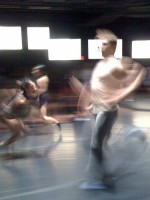In the national dialogue about education reform, the latest trend seems to be emphasizing the skills that lead to creativity and innovation as the best way to prepare students for their future.
I hold that the same is true for dance education.
In looking at the work of current choreographers, it is harder and harder to classify dance neatly into genres. The cross-training that fueled technical development in recent decades has produced artists that are blurring lines organically.
So where are we, as a field, headed? It is anyone’s guess. So maybe our training practices in this decade need a new approach, too.
 Rethinking Tradition
Rethinking Tradition
It used to be that if you were a ballet dancer, your training was predominantly in ballet. Same for jazz, same for modern.
Then, it was important to include other training in your repertoire but maintaining them as separate skills to be called on mostly if a choreographer required you to do so.
Now, we are fusing styles, ideologies, cultures, and genres so seamlessly that it can be difficult to know where one ends and where another begins.
Technique vs. Ballet
In my own classes, I have started talking about technique in broader terms and dropping labels such as “ballet”, “jazz”, and “modern” dance until we are specifically talking about stylizing movement or comparing approaches to common elements.
Those things usually occur later in the curriculum (middle school and high school) because the nature of the conversations are quite complex and rooted in movement analysis, not the imitation of lines.
Due to our conversations of Space, Time, and Energy and relating sub-distinctions, in grades K-5, students understand the differences on a deeper level rather than basic recognition. Their dancing is clearer and their expression of the differences in styles of dance are more articulate.
Understanding the nuts and bolts of movement is much more important for developing creativity than recreating the physical pictures of dance.
Conquering ballet-resistant attitudes
In my current position, there is a percentage of families- parents AND students- that are reluctant to study “ballet”. I have taken this re-occurring conversation as a prompt to retool our thinking about dance training and perceptions of dance for students and families.
When using the movement within a non-ballet class, is it still ballet?
This conversation deepens the critical thinking of dance students but also expands the tolerance of families more comfortable with their students studying other styles of dance.
I explain that…
- This movement exists in many of the styles we will be studying and should be considered technique- an opportunity to discipline the body.
- The purpose of the movement is not to turn their student into a ballet dancer.
- Often this movement isn’t offered within a balletic context.
Furthermore, “ballet” is used to serve as a contrast of approaches to movement through movement analysis, just as would be done within various sports disciplines for athletes.
Other metaphors for technical training: grammar in the creative use of language, or the vitamins found in various types of foods.
(See Nichelle’s break-down in terms of letters in the development of words and writing.)
The Outcomes
With this approach, we are able to broaden the conversation- and analysis- more richly.
When watching iconic works of choreography, we are better able to search for how the movement defies gravity or utilizes gravity rather than looking for overly simplified examples of “ballet” or “modern”.
When it comes to creating their own choreography, students have more tools from which to draw. Their compositions reach beyond a regurgitation of steps. They more effectively take risks by rethinking traditions.
Instead, they may consider, “What constitutes an arabesque and can it be done with a different part of the body?” They can also answer why or why not that would be acceptable within a balletic context, or any other.
This also leads to conversations about where this arabesque line may appear in other disciplines- intersecting lines, angles, arguments, physics, leverage, surface area (pique arabesque).
Dancers know more than just dance. As educators, we must empower our students in sharing their understandings derived through dance experiences.
Let’s make this the new trend in dance education and pave the way for creative, innovative thinkers.
Read more:
- The Right Steps Towards a Career in Dance
- Non-Performance Dance Careers: More Alternatives
- Why Dance Matters: Survival of the Fittest
- What I Missed in College
Have your training methods changed to better equip dancers for their futures?
Tell us what you think about re-thinking tradition!
Heather Vaughan-Southard MFA, is a choreographer, dance educator, and performer based in Michigan. She currently directs the dance program at the Everett High School Visual and Performing Arts Magnet in Lansing. With the philosophy of teaching dance as a liberal art, Ms. Vaughan-Southard collaborates with numerous arts and education organizations throughout the state. She has danced professionally in Chicago, Detroit, Los Angeles, and New York and has performed works by Mia Michaels, Lar Lubovitch, Donald McKayle, Billy Siegenfeld, Alexandra Beller, Debra Levasseur-Lottman, and Bob Fosse. As a choreographer, her work has been credited by the Los Angeles Times for “creating heat.” She has recently choreographed for the dance programs at Michigan State University, Grand Valley State University, Lansing Community College and is the former dance professor at Albion College. She is a regular guest artist and blogger for Dance in the Annex, an innovative dance community in Grand Rapids. Heather received her MFA in Dance from the University of Michigan, BFA in Dance from Western Michigan University and K-12 certification in Dance from Wayne State University. Read Heather’s posts.

